Abstract
We estimated numbers of transplantable primitive stem cells (PSCs) and found evidence that the same PSC continuously produced circulating erythrocytes and lymphocytes. These estimations used the binomial formula on data from recipients of identical portions of marrow mixtures containing two distinguishable cell types. Analysis of variance was used to compare repeated tests within each recipient. Values of pi s or pi c, probabilities that two independently sampled cells were descended from the same PSC, were also estimated, as this does not require the unverified condition that all PSCs contribute equally to the differentiated cell population. Several months after transplantation, erythrocytes were descended from only a single PSC per 1-2 X 10(5) marrow cells injected, several times rarer than previously reported. Percentages of erythrocyte and lymphocyte types in each recipient were closely correlated, with r values ranging from 0.86 to 0.94, in groups receiving 2-8 X 10(5) marrow cells; apparently the same precursors repopulated both myeloid and lymphoid lines in each recipient, as expected of true PSCs. Our data did not fit the clonal succession model, which predicts sequential activation of new PSCs and deactivation of old. Between 76 and 154 days, differentiated erythrocyte precursors were probably exhausted, with no evidence for new precursor activation or for further change between 154 and 250 days. The percentage of newly produced erythrocytes (reticulocytes) of each donor type varied little when individual recipients were followed between 165 and 295 days after transplantation, and variances within recipients were similar at marrow doses from 8 to 200 X 10(5) cells, further contradicting models of sequential activation and deactivation of PSC clones. Thus, transplanted PSCs were continually active during much of the recipient's lifespan.
Full text
PDF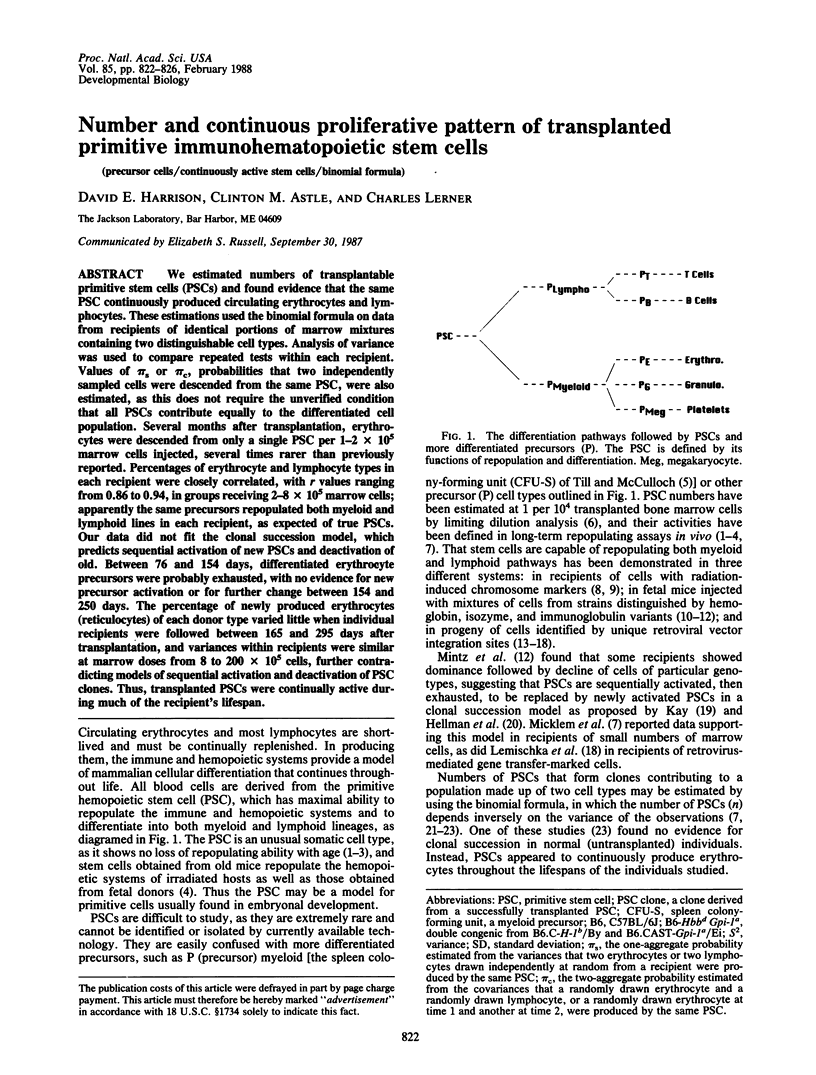
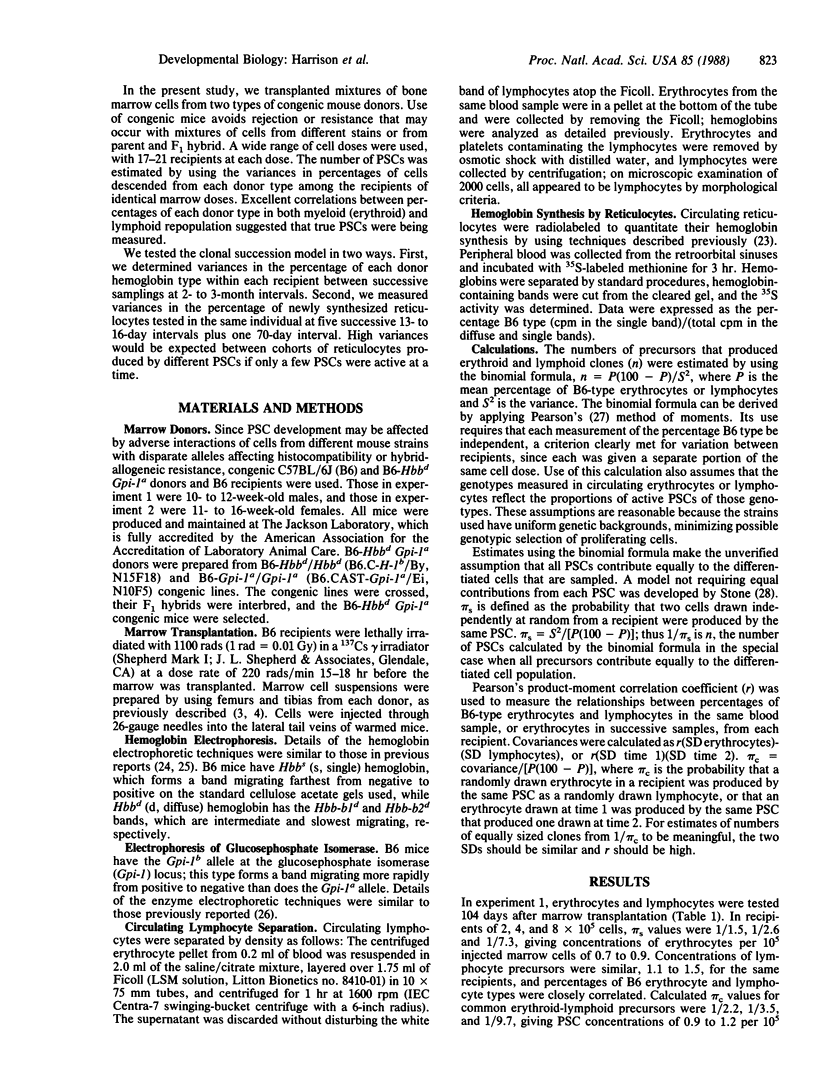
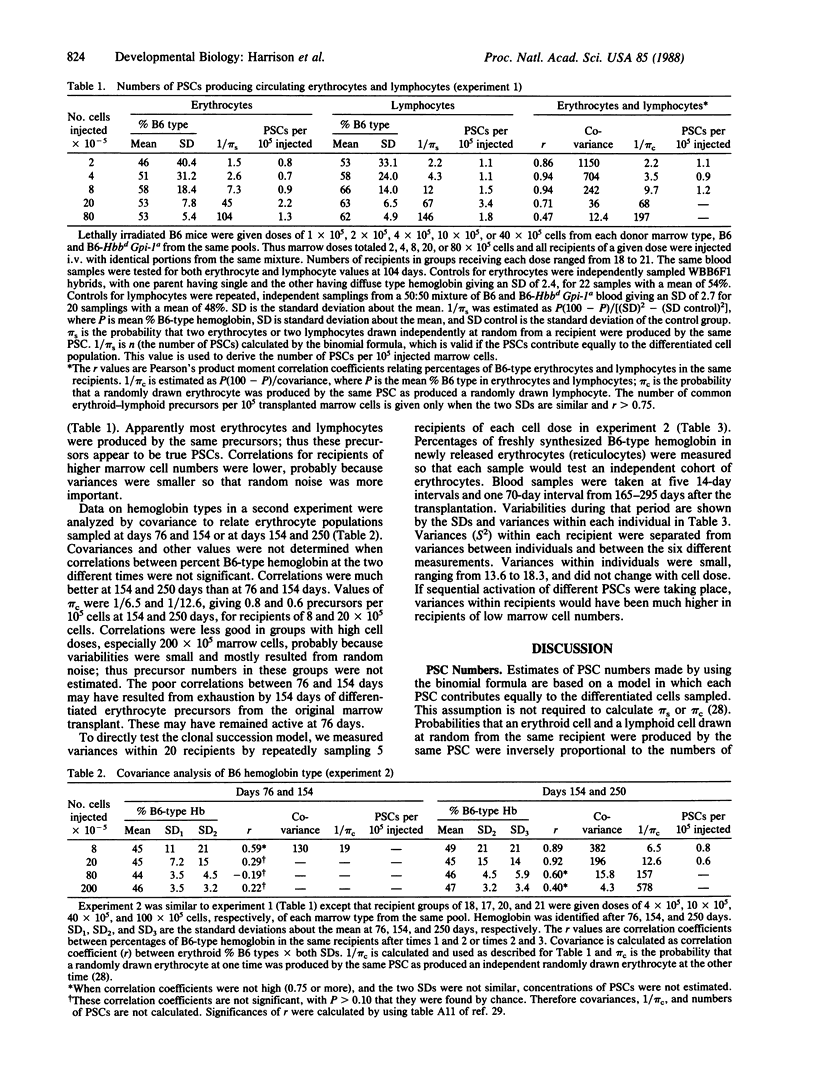
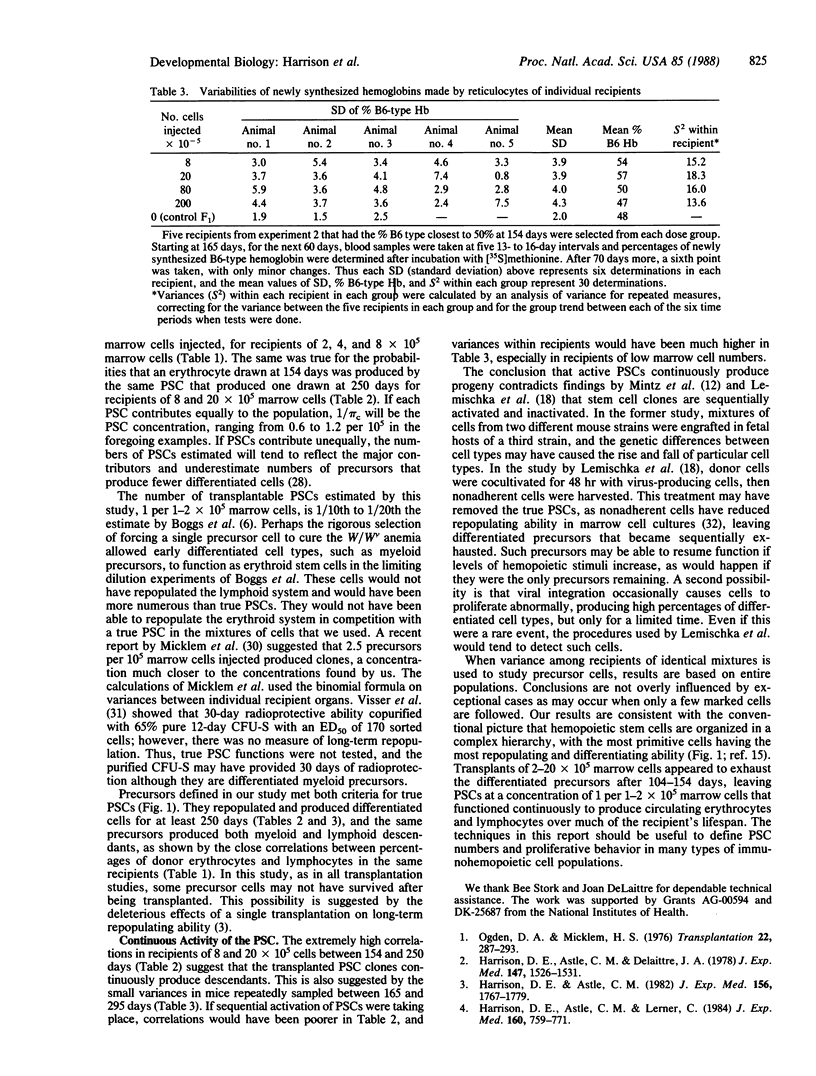
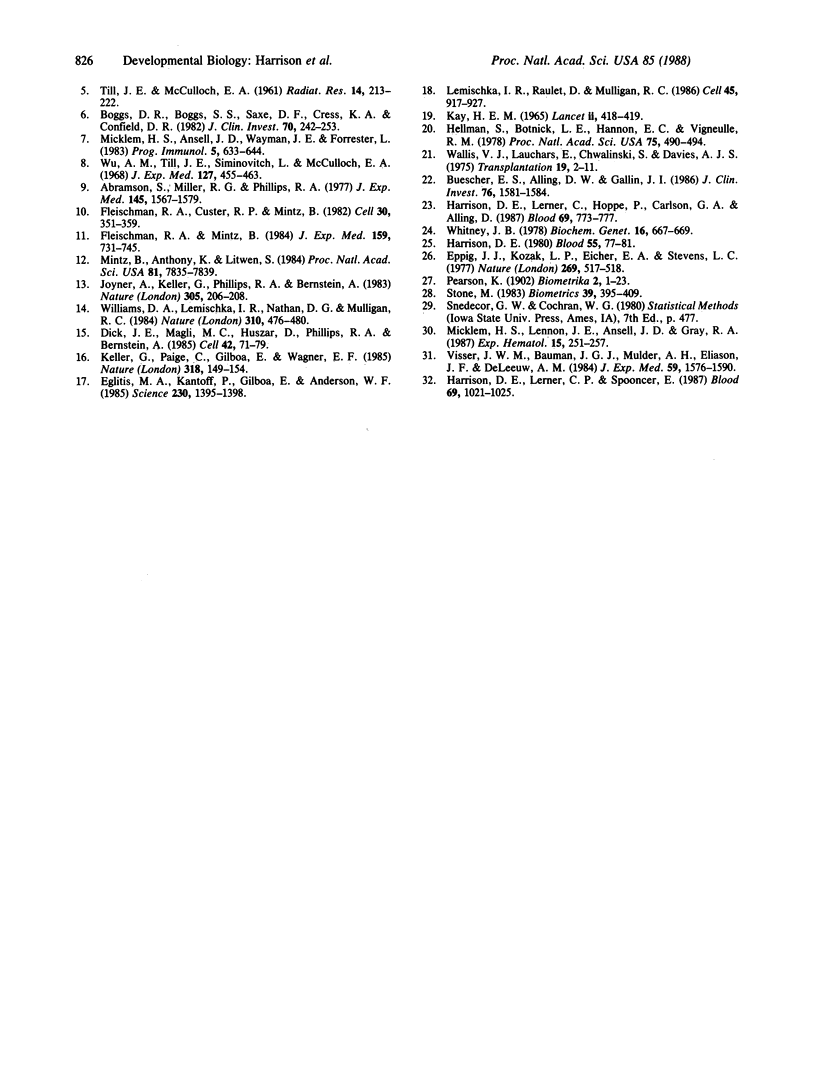
Selected References
These references are in PubMed. This may not be the complete list of references from this article.
- Abramson S., Miller R. G., Phillips R. A. The identification in adult bone marrow of pluripotent and restricted stem cells of the myeloid and lymphoid systems. J Exp Med. 1977 Jun 1;145(6):1567–1579. doi: 10.1084/jem.145.6.1567. [DOI] [PMC free article] [PubMed] [Google Scholar]
- Boggs D. R., Boggs S. S., Saxe D. F., Gress L. A., Canfield D. R. Hematopoietic stem cells with high proliferative potential. Assay of their concentration in marrow by the frequency and duration of cure of W/Wv mice. J Clin Invest. 1982 Aug;70(2):242–253. doi: 10.1172/JCI110611. [DOI] [PMC free article] [PubMed] [Google Scholar]
- Buescher E. S., Alling D. W., Gallin J. I. Use of an X-linked human neutrophil marker to estimate timing of lyonization and size of the dividing stem cell pool. J Clin Invest. 1985 Oct;76(4):1581–1584. doi: 10.1172/JCI112140. [DOI] [PMC free article] [PubMed] [Google Scholar]
- Dick J. E., Magli M. C., Huszar D., Phillips R. A., Bernstein A. Introduction of a selectable gene into primitive stem cells capable of long-term reconstitution of the hemopoietic system of W/Wv mice. Cell. 1985 Aug;42(1):71–79. doi: 10.1016/s0092-8674(85)80102-1. [DOI] [PubMed] [Google Scholar]
- Eglitis M. A., Kantoff P., Gilboa E., Anderson W. F. Gene expression in mice after high efficiency retroviral-mediated gene transfer. Science. 1985 Dec 20;230(4732):1395–1398. doi: 10.1126/science.2999985. [DOI] [PubMed] [Google Scholar]
- Eppig J. J., Kozak L. P., Eicher E. M., Stevens L. C. Ovarian teratomas in mice are derived from oocytes that have completed the first meiotic division. Nature. 1977 Oct 6;269(5628):517–518. doi: 10.1038/269517a0. [DOI] [PubMed] [Google Scholar]
- Fleischman R. A., Custer R. P., Mintz B. Totipotent hematopoietic stem cells: normal self-renewal and differentiation after transplantation between mouse fetuses. Cell. 1982 Sep;30(2):351–359. doi: 10.1016/0092-8674(82)90233-1. [DOI] [PubMed] [Google Scholar]
- Fleischman R. A., Mintz B. Development of adult bone marrow stem cells in H-2-compatible and -incompatible mouse fetuses. J Exp Med. 1984 Mar 1;159(3):731–745. doi: 10.1084/jem.159.3.731. [DOI] [PMC free article] [PubMed] [Google Scholar]
- Harrison D. E., Astle C. M., Delaittre J. A. Loss of proliferative capacity in immunohemopoietic stem cells caused by serial transplantation rather than aging. J Exp Med. 1978 May 1;147(5):1526–1531. doi: 10.1084/jem.147.5.1526. [DOI] [PMC free article] [PubMed] [Google Scholar]
- Harrison D. E., Astle C. M., Lerner C. Ultimate erythropoietic repopulating abilities of fetal, young adult, and old adult cells compared using repeated irradiation. J Exp Med. 1984 Sep 1;160(3):759–771. doi: 10.1084/jem.160.3.759. [DOI] [PMC free article] [PubMed] [Google Scholar]
- Harrison D. E., Astle C. M. Loss of stem cell repopulating ability upon transplantation. Effects of donor age, cell number, and transplantation procedure. J Exp Med. 1982 Dec 1;156(6):1767–1779. doi: 10.1084/jem.156.6.1767. [DOI] [PMC free article] [PubMed] [Google Scholar]
- Harrison D. E. Competitive repopulation: a new assay for long-term stem cell functional capacity. Blood. 1980 Jan;55(1):77–81. [PubMed] [Google Scholar]
- Harrison D. E., Lerner C. P., Spooncer E. Erythropoietic repopulating ability of stem cells from long-term marrow culture. Blood. 1987 Apr;69(4):1021–1025. [PubMed] [Google Scholar]
- Harrison D. E., Lerner C., Hoppe P. C., Carlson G. A., Alling D. Large numbers of primitive stem cells are active simultaneously in aggregated embryo chimeric mice. Blood. 1987 Mar;69(3):773–777. [PubMed] [Google Scholar]
- Hellman S., Botnick L. E., Hannon E. C., Vigneulle R. M. Proliferative capacity of murine hematopoietic stem cells. Proc Natl Acad Sci U S A. 1978 Jan;75(1):490–494. doi: 10.1073/pnas.75.1.490. [DOI] [PMC free article] [PubMed] [Google Scholar]
- KAY H. E. HOW MANY CELL-GENERATIONS? Lancet. 1965 Aug 28;2(7409):418–419. doi: 10.1016/s0140-6736(65)90763-4. [DOI] [PubMed] [Google Scholar]
- Keller G., Paige C., Gilboa E., Wagner E. F. Expression of a foreign gene in myeloid and lymphoid cells derived from multipotent haematopoietic precursors. Nature. 1985 Nov 14;318(6042):149–154. doi: 10.1038/318149a0. [DOI] [PubMed] [Google Scholar]
- Lemischka I. R., Raulet D. H., Mulligan R. C. Developmental potential and dynamic behavior of hematopoietic stem cells. Cell. 1986 Jun 20;45(6):917–927. doi: 10.1016/0092-8674(86)90566-0. [DOI] [PubMed] [Google Scholar]
- Micklem H. S., Lennon J. E., Ansell J. D., Gray R. A. Numbers and dispersion of repopulating hematopoietic cell clones in radiation chimeras as functions of injected cell dose. Exp Hematol. 1987 Mar;15(3):251–257. [PubMed] [Google Scholar]
- Mintz B., Anthony K., Litwin S. Monoclonal derivation of mouse myeloid and lymphoid lineages from totipotent hematopoietic stem cells experimentally engrafted in fetal hosts. Proc Natl Acad Sci U S A. 1984 Dec;81(24):7835–7839. doi: 10.1073/pnas.81.24.7835. [DOI] [PMC free article] [PubMed] [Google Scholar]
- Ogden D. A., Mickliem H. S. The fate of serially transplanted bone marrow cell populations from young and old donors. Transplantation. 1976 Sep;22(3):287–293. doi: 10.1097/00007890-197609000-00010. [DOI] [PubMed] [Google Scholar]
- Rubin J. S., Joyner A. L., Bernstein A., Whitmore G. F. Molecular identification of a human DNA repair gene following DNA-mediated gene transfer. Nature. 1983 Nov 10;306(5939):206–208. doi: 10.1038/306206a0. [DOI] [PubMed] [Google Scholar]
- Stone M. A general statistical model for clone--tissue studies, using X-chromosome inactivation data. Biometrics. 1983 Jun;39(2):395–409. [PubMed] [Google Scholar]
- TILL J. E., McCULLOCH E. A. A direct measurement of the radiation sensitivity of normal mouse bone marrow cells. Radiat Res. 1961 Feb;14:213–222. [PubMed] [Google Scholar]
- Visser J. W., Bauman J. G., Mulder A. H., Eliason J. F., de Leeuw A. M. Isolation of murine pluripotent hemopoietic stem cells. J Exp Med. 1984 Jun 1;159(6):1576–1590. doi: 10.1084/jem.159.6.1576. [DOI] [PMC free article] [PubMed] [Google Scholar]
- Wallis V. J., Leuchars E., Chwalinski S., Davies A. J. On the sparse seeding of bone marrow and thymus in radiation chimaeras. Transplantation. 1975 Jan;19(1):2–11. doi: 10.1097/00007890-197501000-00002. [DOI] [PubMed] [Google Scholar]
- Whitney J. B., 3rd Simplified typing of mouse hemoglobin (Hbb) phenotypes using cystamine. Biochem Genet. 1978 Aug;16(7-8):667–672. doi: 10.1007/BF00484723. [DOI] [PubMed] [Google Scholar]
- Williams D. A., Lemischka I. R., Nathan D. G., Mulligan R. C. Introduction of new genetic material into pluripotent haematopoietic stem cells of the mouse. Nature. 1984 Aug 9;310(5977):476–480. doi: 10.1038/310476a0. [DOI] [PubMed] [Google Scholar]
- Wu A. M., Till J. E., Siminovitch L., McCulloch E. A. Cytological evidence for a relationship between normal hemotopoietic colony-forming cells and cells of the lymphoid system. J Exp Med. 1968 Mar 1;127(3):455–464. doi: 10.1084/jem.127.3.455. [DOI] [PMC free article] [PubMed] [Google Scholar]


